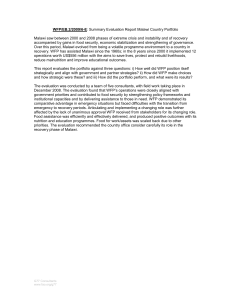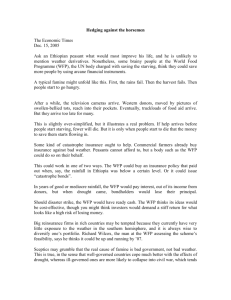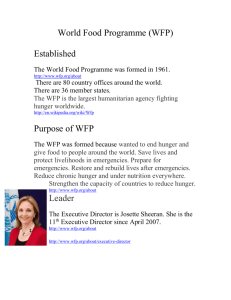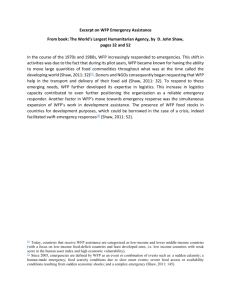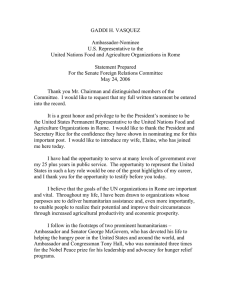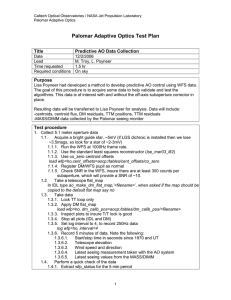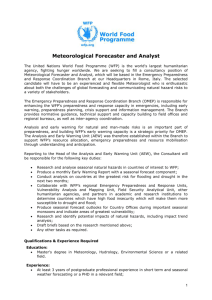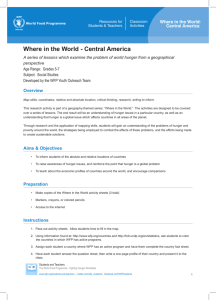The Effectiveness of Food Aid: By what Measure? Patrick Webb
advertisement
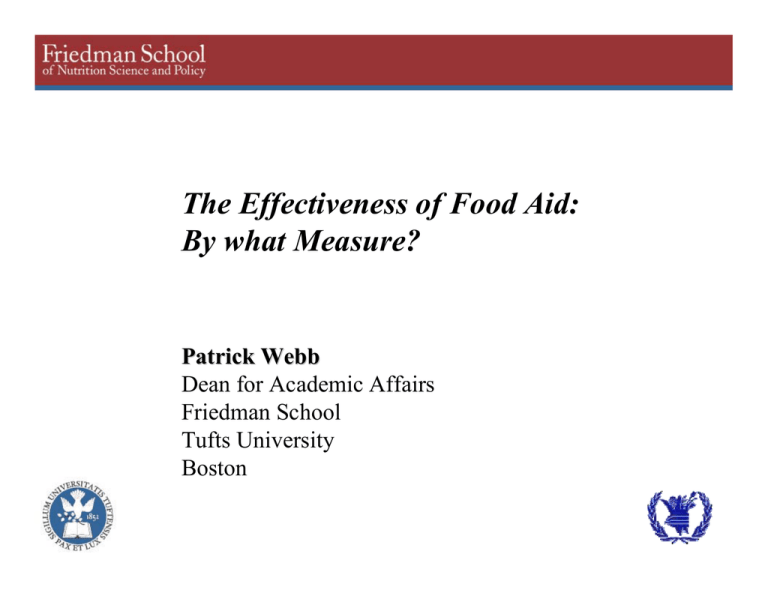
The Effectiveness of Food Aid: By what Measure? Patrick Webb Dean for Academic Affairs Friedman School Tufts University Boston Thrust of my remarks: a) “Effectiveness” must be defined by beneficiary needs b) ‘Food aid’ is not all same; new products/protocols c) Quickest, least costly, nutritionally most appropriate answer to meeting beneficiary needs will involve, i) more resources supporting food aid and ii) more flexibility in those resources—however achieved. Value WFP Food Procurement Trends 1990-2004 (US$) Quantity (MTs) $1,200 4 3.5 3 2.5 2 1.5 1 0.5 0 $1,000 $800 $600 $400 $200 $0 '90 91 92 93 94 95 96 97 98 99 '00 '01 '02 '03 '04 Value US Million $ Qty (millionTons) Local /regional purchases ¾1.6 of 7.5 million tons global food aid (2004) procured in developing countries. ¾ 2001-2004, WFP bought 1.25 m MT p.a. (US$ 263 million) in developing countries ¾2004 alone: 3.6 Million MT (US$ 1.1 Billion) (1.5 million MT (US $ 310 million) was for Iraq operation) ¾Countries from which WFP procures rising: 78 in 2001, 91 in 2004. Location of WFP Local Purchases (2004) 91 Countries, of which 79 Developing/in Transition N. America 510,345 MT Europe 269,177 MT Asia 1,165,744 MT Latin America 303,646 MT Africa 818,662 MT Oceania 490,069 MT Origin of WFP Locally Procured food Selected Developing Countries (2004) Country Uganda South Africa Ethiopia India Bangladesh Afghanistan Sudan Honduras Tajikistan US$ 26.5 25.6 25.3 30.3 11.5 2.2 20.7 1.1 0.2 ‘000MT 111.7 107.5 127.8 100.5 27.6 10.6 123.2 3.4 0.6 Uganda ¾1994-2004 WFP procured 600,000 MT of food, worth US$140 million ¾2004 alone, purchases were 115,000 MT (maize and beans), worth US$28 million ¾WFP ‘saved’ US$12 million on maize and beans from Uganda versus import ¾ But, fortified veg. oil more costly locally; monopolistic tendencies growing among suppliers (3 firms supply 60% of food); quality control a problem; peace in Sudan and Gulu could ‘kill’ market. Origin of WFP-procured food 31% from developed countries COUNTRY Australia Belgium Canada Denmark France Germany Italy Japan Netherlands Spain United Kingdom USA TOTAL QUANTITY MT 490,069 30,684 128,448 27,243 19,286 1,190 39,972 58,537 21,734 3,000 121 381,897 1,202,181 VALUE US$ 85,699,884 23,386,107 34,591,643 19,111,617 48,749,079 339,008 11,547,454 13,277,817 14,093,148 7,561,500 42,253 67,527,621 325,927,130 Donors providing cash to WFP for purchases (selected) Local/regional % Triangular % European Commission 25 European Commission 28 23 Germany 9 Japan Norway 8 Sweden 7 United Kingdom 8 United Kingdom 6 Challenges to local food purchasing ¾ Food safety (e.g. aflatoxins) ¾ Moisture content (storage, transport losses) ¾ Finding 'surpluses' (when locals eat a little more) ¾ Local micronutrient fortification where needed More challenges ¾ Technology for tailored, blended foods ¾ Balanced food basket (6 to 12 items simultaneously) ¾ Cost of transport (insurance, 'hazard pay‘, timeliness ¾ Multi-stop trans-shipment (warehousing at scale) ¾ Lack of functional banking systems, More challenges ¾ Transparency (monopolies, private sector) ¾ Interpreting dysfunctional markets (distorted signals) ¾ Functioning local judiciary to enforce contracts ¾ Predictable supply in regions of high food insecurity, closed borders, impeded access In sum: ¾ Local purchases do make sense/are feasible ¾ WFP welcomes flexibility of untied, cash ¾ But, the practice is more challenging than theory or political debate suggests. ¾ Need to enter this arena with eyes open: ¾Calculate ‘costs’ in more refined terms ¾Enable appropriate players to do it well ¾Keep beneficiary needs at core of ‘effectiveness’ ¾More resources for food aid needed, not less
